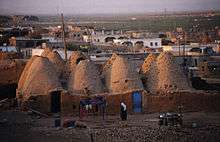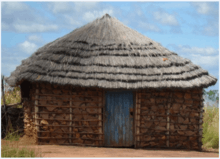Beehive house
This article is about a type of human dwelling. For other uses, see Beehive (disambiguation).
For Brigham Young's house in Salt Lake City, see Beehive House.

Another view of beehive houses in Harran.
A beehive house is a building made from a circle of stones topped with a domed roof. The name comes from the similarity in shape to a straw beehive.
Occurrences
The ancient Bantu used this type of house, which was made with mud, poles, and cow dung. Early European settlers in the Karoo region of South Africa built similar structures known as corbelled houses.
Beehive houses are some of the oldest known structures in Ireland and Scotland,[1] dating from as far back as around 2000 BC and some were still being built as late as the 19th century in Apulia (south-eastern Italy).
See also
- Beehive tomb
- Clochán, Irish stone huts, often beehive shaped
- Dovecote also called doocot (Scots), buildings to house doves, some are beehive shaped, stone structures.
- Musgum mud huts, huts of the Musgum people in Cameroon
- Nuraghe, large, round, neolithic, stone structures in Sardinia.
- Trullo, a southern Italian type of beehive house
References
- ↑ "Chamber's Encyclopaedia: Volume I", J. B. Lippincott & Co. (1870), p.806.
![]() Media related to Beehive houses at Wikimedia Commons
Media related to Beehive houses at Wikimedia Commons
This article is issued from Wikipedia - version of the 11/5/2016. The text is available under the Creative Commons Attribution/Share Alike but additional terms may apply for the media files.

